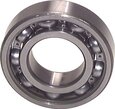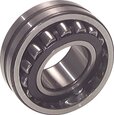Bushing vs Bearing: What is Best for Your Application?
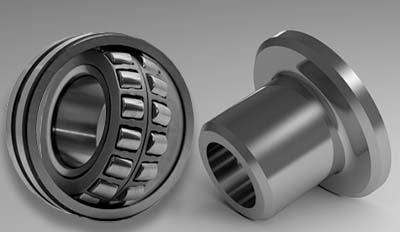
Figure 1: Bearing (left) and bushing (right)
Our world relies heavily on various types of machines with moving parts, all of which would grind to a halt without bushings and bearings. The primary function of bushings and bearings is to reduce the friction created when two moving components interact, reducing the energy required to set them in motion and limiting wear on the components. In this article we explain the main characteristics of the two.
Table of contents
- What are bushings and bearings used for?
- What is a bushing?
- Types of bushings
- Bushing selection considerations
- Bushing maintenance
- Applications of bushings
- What is a bearing?
- Main types of bearings
- Bearing selection criteria
- Bearing maintenance
- Applications of bearings
- Bushing vs bearing
- Choosing between bearings and bushings
- FAQs
View our online selection of bearings!
What are bushings and bearings used for?
Both bushings and bearings provide solutions to reducing friction and limiting wear on components, but each is best suited for use in different operating and environmental conditions. Selecting the right one to meet those conditions requires understanding the difference between the two, their advantages and disadvantages, and the typical applications for which they are used.
Bearings of various types are used to reduce friction and support the stress of multiple kinds of loading. Figure 2 shows the various types of loading:
- A: Radial loading for rotating motions
- B: Axial loading for sliding motions
- C: A combination of sliding and rotating movements
- D: Moments of impact (shock loading)
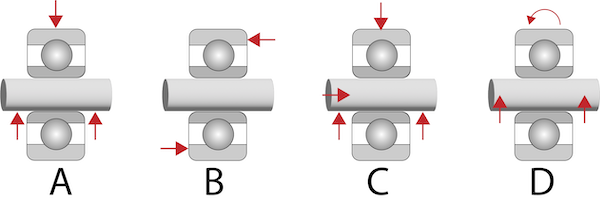
Figure 2: Various types of loading: radial (A), axial (B), sliding and rotating combination (C), and shock loading (D).
Technically speaking, the bushing is a classification within the overall class of bearings. It is defined by its single-component design in contrast to two or more components, like various other types of bearings. A bushing comprises several different materials combined to form a single load-carrying assembly. They are often used with heavier loads at slower speeds and can withstand substantial load transfer and shock loading.
In contrast, bearings are multiple component precision-made machine parts that allow the rotating shafts of machinery to move at extremely high speeds, reducing friction between moving parts and handling radial loading stress. Though dealing with radial loading is the primary function of bearings, some are also designed to handle axial and shock loading.
What is a bushing?
A bushing is a cylindrical component designed to support loading on a shaft that operates with sliding motion between the moving surfaces. A bushing is a single element component, though it might be composed of several different materials.
Also called sleeve bearings, bushings slide over rods or shafts to provide an extremely low-friction motion, providing excellent shock absorption and work to minimize energy usage, noise, and wear.
Types of bushings
The two main types of bushings include sleeve and flange bushings. When designed with flanges, they can handle combined loads. Bushings can be threaded on the inside or outside surface to accommodate various assembly conditions.
In addition to the different types, bushings of different material compositions are also available. The material composition of a bushing helps it withstand various conditions in an operating environment, like corrosion, high temperatures, high pressure, and impact.
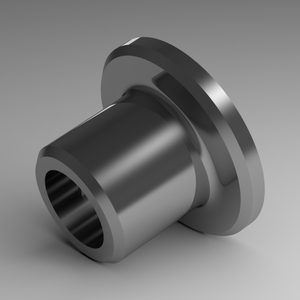
Figure 3: Flanged bushing
Bronze and metal bushings
Bronze bushings are typically made of continuous cast bronze material to ensure a uniform structure. They are general-purpose bushings with excellent load carrying and wear protection capabilities while having the capacity to withstand high levels of heat (temperatures of up to 450°F). Metal bushings can also be made of various metals or alloys to enhance their capabilities, including steel or stainless steel, brass, aluminum, and copper.
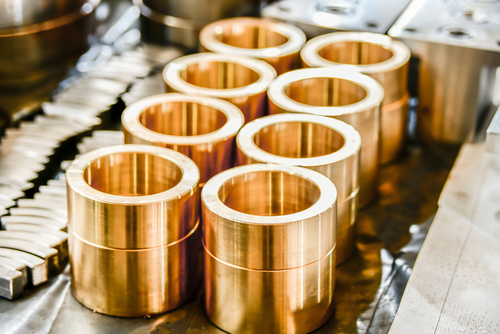
Figure 4: Bronze bushings
Plastic bushings
The lightweight, corrosion-resistant properties of solid plastic bushings make them very popular. Modern plastics can overcome previous concerns, such as heat sensitivity, softening, wear, or reduced life at elevated temperatures. They are a good choice for wet or humid environments, like dry kiln cartwheels at lumber drying facilities, where the water acts as a lubricant for the bushing. Though quite popular, plastic is not the recommended bushing material for heavy loads. It tends to crack under a high load, and misalignment is common if manufacture or assembly is not precise, especially with off-the-shelf bushings. When plastic is specified, polytetrafluoroethylene (PTFE) is the engineering plastic material of choice.
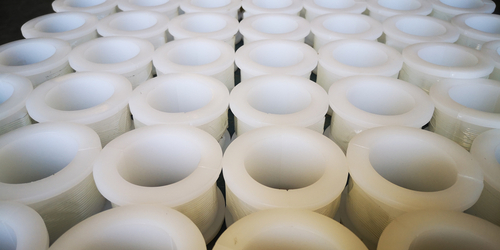
Figure 5: Plastic bushings
Bushing selection considerations
When choosing bushing for a particular application, the build-up of heat due to friction must be considered. The principal factors influencing heat are surface velocity (V) and unit pressure (P). To determine if the bushing is appropriate for any application, the safe operation involves ensuring that the application's calculated PV value is lower than the manufacturer's limiting PV value.
Use the following formulae in the process of selecting a bushing for your application:
- Calculate the value of PV of your application by PV = P ✕ V
- Determine surface velocity (V) from:
V = 0.262 × rpm × D
- rpm: shaft revolutions / minute
- D: shat diameter (in inches).
- Unit pressure, P = Total Load (lbs)/Contact Area(in²)
Contact Area = D x L
- L: Bushing length
The calculated values correspond to the specified capacities of each manufactured bushing, which can be used to select the bushing best suited for the application.
Bushing maintenance
Maintenance and inspection, which includes surveying operating conditions for any abnormalities, such as changes in noise, vibration, and temperature, is critical in preventing bushing failures. Flaking, scoring, cracking, corrosion, and abnormal wear must be addressed immediately.
Bushings tend to be self-lubricating and ideal for low-maintenance or maintenance-free operations. Still, self-lubrication is also possible by a uniform pattern of indents on the surface of the bushing that acts as grease reservoirs. Many nylon bushings operate without lubricants, making them a solid choice for drier food and textile industry applications.
Applications of bushings
Bushings are the most important component of power transformers, allowing for relative motion by sliding compared to rolling. Vehicle suspension systems are among the most common applications of bushings, where rubber bushings are used throughout a vehicle's suspension to ensure a balance between a good ride and reasonable durability. In contrast, rotary bushings are common in machine-related operations that require precision machined parts. Sleeve bushings help control friction and wear in dynamically-loaded applications. Dry kiln cartwheels at lumber drying facilities make use of plastic bushings.
What is a bearing?
Most bearings are used to support rotating shafts in machines, allowing relative movement between the components of machines while providing some type of location between them. The form of bearing used depends on the nature of the relative movement and the type of constraints applied to it.
The majority of bearings are distinguished from bushings by their multiple component designs, which include a cage to contain the rolling elements (balls or rollers), the rolling elements, and an inner (adjacent to the shaft) and outer race (in contact with the bore) upon which the rolling elements interact.
Bearings are a critical component because metal-on-metal contact is abrasive, causing material degradation and creating a resisting force in the form of friction. Bearings allow the two interacting surfaces to roll, slide or glide over each other rather than grinding against each other by transferring the weight of the load to the rolling elements, allowing the device to spin.
Main types of bearings
Bearings may be divided into two general classes:
- Journal bearings: The load acts at right angles to the axis.
- Thrust bearings: The load acts parallel to the axis.
Within both classes, there are different types of bearings that have the same basic structure and purpose. The main difference is the type of load they're handling and what type of rolling element is used. Here are brief examples of each type:
Ball bearings
The rolling element in ball bearings is perfectly spherical balls between the bearing races as a rolling element to maintain separation between the bearing races. Ball bearings can spin in any direction due to their spherical shape, which makes them able to support combined loads (radial and axial). They minimize rotational friction, but they include limited contact areas. They are best for light to medium applications instead of heavy loads or impact.

Figure 6: Ball bearing exploded view
Straight roller bearings
Also known as cylindrical bearings, straight roller bearings run in cylindrical races, providing low-friction and suitable for high-speed and high-radial use. Because of the broader areas of contact on the rollers can handle heavier radial loads like those of conveyor belts but are not the best choice for combined loads.

Figure 7: Straight roller bearing
Tapered roller bearings
Tapered roller bearings have rings and rollers that are tapered and shaped like truncated cones. This shape allows them to overcome the limitations of straight roller bearings and handle combined loads while also supporting heavier loads than ball bearings. The angle of the axis between the roller and the bearing determines its load capacity, allowing for a more significant axial load as the angle increases.
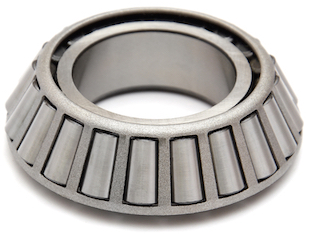
Figure 7: Tapered roller bearing
Bearing selection criteria
Bearings are generally better suited to the support of wheels with higher velocities and lighter loads. When selecting a bearing, consider the following points:
- The load condition applied to the bearing helps determine which type of bearing to use.
- Determining the amount of space available for the bearing is critical in selecting the correct bearing for your application.
- It is critical to know the load carried by the wheel and match it with a bearing designed to handle that load.
Bearing maintenance
Surveying for abnormalities like noise, vibration, and temperature changes is critical for preventing bearing failures. Flaking, scoring, cracking, corrosion, and abnormal wear require immediate attention. Some bearings also require regular lubrication to perform correctly or maintain service life.
Applications of bearings
- Ball and roller bearings involve rolling contact between components interacting with each other in a machine.
- Vehicles are the primary areas where bearings are used, including the wheels, steering mechanism, transmission, and suspension components.
- Bearings also find extensive applications in aircraft, pumps, power turbines, manufacturing machine tools, and home appliances, to name a few. Their primary purpose is to provide high-velocity, high-precision, low-load applications.
Bushing vs bearing
Various factors determine whether bushings or bearings are the right choices for your specific application. Each has its advantages and disadvantages that must be considered in the selection process.
Bushing
Advantages
- Though bushing is technically a class of bearing, it is a single component designed to support a shaft. It operates with sliding motion between the moving surfaces, providing an extremely low friction motion that minimizes power consumption, noise, and wears on parts.
- As a single component, bushings hold an advantage over bearings in the assembly process and tend to cost less.
- They tend to be self-lubricating and provide quieter operation than most bearings.
Disadvantages
- Bushings have to overcome static friction forces before moving, known as stick and slip, especially when the linear motion system is worn or not properly aligned, causing the bushing to move in a jerky, uneven motion.
- Bushings, especially cheap ones, tend to have wider tolerances for a less precise fit on the smooth rods.
Bearings
Advantages
- The motion provided by bearings is generally smoother than bushings, overcoming static friction by rolling instead of sliding.
- They tend to be more precisely built with tighter tolerances for a better fit than bushings, reducing sloppiness and backlash.
- Bearings have a significant advantage over bushings in a high-velocity environment as well.
Disadvantages
- The high cost (approximately six-ten times) compared to the cost of bushings.
- Requires heavy maintenance, often including lubrication
- Loud operation
- A poorly fitted or damaged bearing can cause damage to other components if they break apart.
Choosing between bearings and bushings
Factors to keep in mind when deciding whether to go with bushings or bearings should include the following, in order of priority:
- Velocity and loading: Will the wheels carry heavier loads at slower speeds or lighter loads at higher speeds? In instances where high-velocity is a factor, bearings provide a better solution, while bushings respond well to low-speed, heavy load applications.
- Smoothness of operation: Because of the "stick and slip" issues common with bushings, bearings are the better choice for smoother operation.
- Maintenance/Lubrication: Maintenance-free applications with self-lubrication, especially in the drier food and textile industries, tend to favor bushings.
- Operating noise: When a quiet operation is a critical consideration, bushings are generally quieter than bearings.
- Budget: Bushings tend to cost six to ten times less than bearings.
The specific application, its operating environment, and the various operating conditions and limitations applied to it must be considered when choosing between bearings and bushings. Understanding the advantages and disadvantages of each type helps to determine which one provides the best solution.
FAQs
What is a self-lubricating bearing?
Self-lubricating bearings are a special type of bearing that have lubricant, liquid (oil), or solid (graphite) impregnated within the sliding layer of the bearing. The lubricant is delivered through the pores in the sliding layer during operation, hence lubricating the surface of the bearing.
Why use bronze bushings?
Bronze comes in various alloys and compositions. These bushings are hard and strong, have longer lifespans, and can better resist shock and impact, wear, and corrosion.
How does the performance of sleeve bearings (bushings) and ball bearings compare?
The performance advantages of sleeve bearings include lower cost, less maintenance, reduced noise at low speeds, and easier installation where the load is higher and velocity is lower. In contrast, the performance advantages of ball bearings include smoother operation and an increased capacity to handle higher velocity loads.
What factors should be considered when choosing a bearing?
Loads, speeds, orientation, and space within the operating conditions and your application environment are primary factors to be considered when choosing a bearing. Additional factors include smoothness, noise level, cost, and maintenance requirements.




